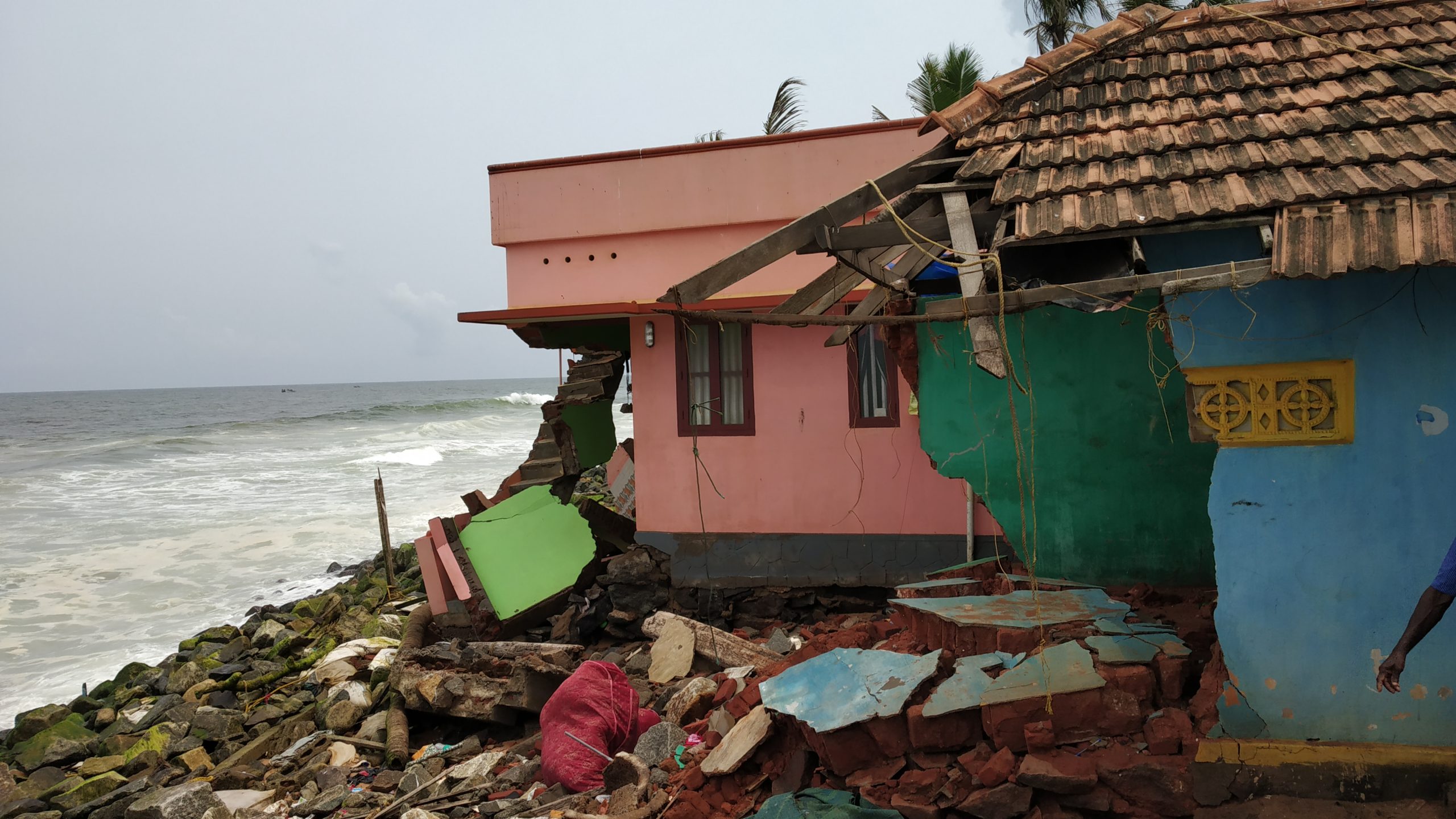Experts and activists believe building sea walls alone is not a solution. Neither is displacing fishing communities from their lands.

The sea is creeping up as the soil erodes in Valiyathura. (Wikimedia Commons)
Magline Philomina Yohannan, a fisherwoman and an activist from Valiyaveli in Thiruvananthapuram, recounts her teenage days when she had to walk to the beach in the scorching afternoon heat to help her fisherfolk parents.
“During the seasons when fish like natholi (anchovy) and mathi (sardine) are in abundance, we used to walk a long distance from our homes to the beach to help our parents pick the fish from the fishing nets and do the processing. Due to the heat, we would carry a wet cloth with us and stop midway to step on it to cool our feet,” she recalls.
Today, she doesn’t need to walk anymore. “The sea has come near to our homes,” says Philomina.
Soil erosion along Kerala’s coast is a real and pressing issue, and the state is currently witnessing a series of protests demanding the construction of sea walls to help prevent erosion. Ernamkulam district has become the epicentre of these protests.
The Kerala coastline is 590 km long and makes up 10 percent of the total coastline of India. Seventy-seven percent of the fishing community and 30 percent of the entire population in the state reside near the seashore, which makes up to 15 percent of the total land area of Kerala.
Unlike other coastal areas in the country, Kerala’s coastal lowlands are densely populated and have an average density of 2,022 per sq km, while the state’s average is 859.
Climate rights activist AJ Vijayan believes soil erosion along Kerala’s seashore is due to human interventions close to the coastline.
“The data available clearly shows that there is erosion on the one hand and construction on the other. The sea wall is not at all an answer. The answer is to preserve all the beaches. Only healthy beaches can tackle soil erosion. But we are destroying our beaches by erecting these walls and it is not helping to solve the issue. Instead, it is aggravating it,” says Vijayan.
A report on Kerala’s shores titled ‘Shore Line Change Assessment for Kerala Coast’, published by the Ministry of Environment, Forest and Climate and released by the then minister Jairam Ramesh, maps shoreline changes of the Kerala coast.
According to the report, the coastline of India is undergoing changes due to human interventions and the majority of the shoreline changes are on account of the structures which have been constructed along the foreshore of the coast.
The report concludes that “the major stretch of Kerala’s coastline (63 percent) is eroding (including artificial coast). It is advised that proper precautions be taken prior to erecting any further structures along the eroding and vulnerable coastal stretches of Kerala”.
This warning by the ministry has, however, fallen on deaf ears and construction along the coast has only increased.
Prof A Bijukumar, who heads the Department of Aquatic Biology and Fisheries at the University of Kerala, spoke to South First on the relevance of the sea wall.
Two-thirds of the coastal lowlands in Kerala are protected by sea walls, says Bijukumar, adding that the sea wall itself becomes a triggering mechanism for soil erosion.
He, however, doesn’t recommend getting rid of them in areas where the turbulent sea could lead to a catastrophe. According to him, places where there have been large erosions are those that have seen coastal developmental activities or fishing harbours.
A study co-written by Kumar observes, “In Kerala coasts, erosion (removal of sand) occurs from May to September, and accretion (addition of sand) occurs from November to March. This is the science of seashore structural dynamics. Any permanent construction across the longitudinal drift will destabilise this dynamic system.”
The government of Kerala set up the Punargeham Project utilising ₹1,398 crore from the Chief Minister’s Disaster Relief Fund (CMDRF). The project aims to rehabilitate fishermen’s families residing 50m from the High Tide Line (HDL). The project has been subject to severe criticism as it deprives fishing communities of their lands by the sea from which they earn a living.
“I am asked to relocate as I live within 50m of the shore. The government promises ₹10 lakh as compensation. At the same time, adjacent to my house there is the Vikram Sarabhai Space Centre, there is Travancore Titanium factory and Thiruvananthapuram domestic airport. The government will provide all the protection to these groups by providing sea walls and other precautionary measures. What kind of justice is this?” asks Philomina.
Philomina accuses the government not doing enough to find a solution to the soil erosion problem, and also of consciously ignoring the issue of fishing communities being displaced from their land.
The late Kallen Pokkudan — known as the ‘Mangrove Man of India’ — had advocated planting mangrove forests near Kerala’s sea shores. Mangroves are considered vital to combat the erosion of land near the sea and protect the land from high tides.
Kumar agrees, but with a caveat.
“Natural solutions like mangroves are effective to counter soil erosion. But this is not applicable in all locations in Kerala. For example, in places like Chellanam in Kochi, the soil erosion is so high that the only solution possible at the moment is to build sea walls,” he told South First.
Kumar also recommends nourishing the beaches. According to him, doing adequate sand budgeting and depositing back the sand that is lost from the beaches can go a long way to reduce the impacts of soil erosion on shores.

Apr 25, 2024

Apr 25, 2024

Apr 25, 2024

Apr 25, 2024

Apr 24, 2024

Apr 24, 2024